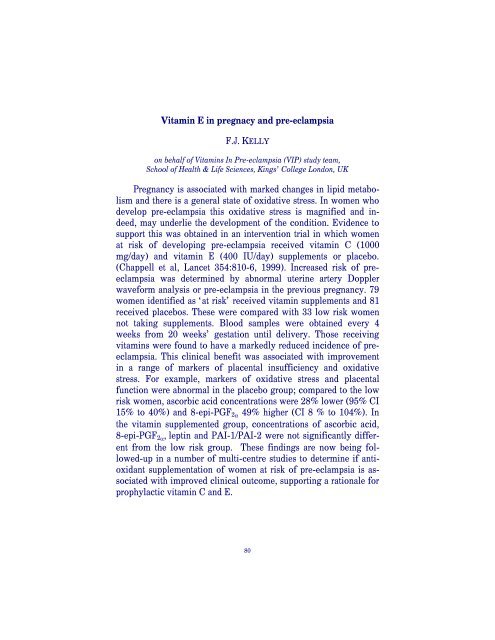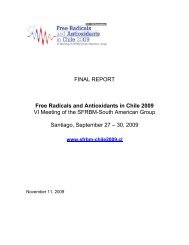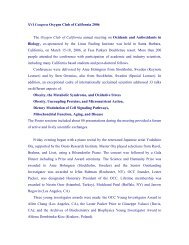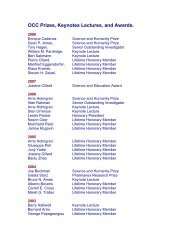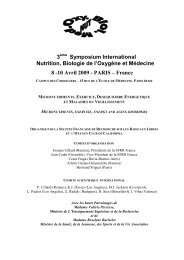oxidants and antioxidants in biology - Oxygen Club of California
oxidants and antioxidants in biology - Oxygen Club of California
oxidants and antioxidants in biology - Oxygen Club of California
Create successful ePaper yourself
Turn your PDF publications into a flip-book with our unique Google optimized e-Paper software.
Vitam<strong>in</strong> E <strong>in</strong> pregnacy <strong>and</strong> pre-eclampsia<br />
F.J. KELLY<br />
on behalf <strong>of</strong> Vitam<strong>in</strong>s In Pre-eclampsia (VIP) study team,<br />
School <strong>of</strong> Health & Life Sciences, K<strong>in</strong>gs’ College London, UK<br />
Pregnancy is associated with marked changes <strong>in</strong> lipid metabolism<br />
<strong>and</strong> there is a general state <strong>of</strong> oxidative stress. In women who<br />
develop pre-eclampsia this oxidative stress is magnified <strong>and</strong> <strong>in</strong>deed,<br />
may underlie the development <strong>of</strong> the condition. Evidence to<br />
support this was obta<strong>in</strong>ed <strong>in</strong> an <strong>in</strong>tervention trial <strong>in</strong> which women<br />
at risk <strong>of</strong> develop<strong>in</strong>g pre-eclampsia received vitam<strong>in</strong> C (1000<br />
mg/day) <strong>and</strong> vitam<strong>in</strong> E (400 IU/day) supplements or placebo.<br />
(Chappell et al, Lancet 354:810-6, 1999). Increased risk <strong>of</strong> preeclampsia<br />
was determ<strong>in</strong>ed by abnormal uter<strong>in</strong>e artery Doppler<br />
waveform analysis or pre-eclampsia <strong>in</strong> the previous pregnancy. 79<br />
women identified as ‘at risk’ received vitam<strong>in</strong> supplements <strong>and</strong> 81<br />
received placebos. These were compared with 33 low risk women<br />
not tak<strong>in</strong>g supplements. Blood samples were obta<strong>in</strong>ed every 4<br />
weeks from 20 weeks’ gestation until delivery. Those receiv<strong>in</strong>g<br />
vitam<strong>in</strong>s were found to have a markedly reduced <strong>in</strong>cidence <strong>of</strong> preeclampsia.<br />
This cl<strong>in</strong>ical benefit was associated with improvement<br />
<strong>in</strong> a range <strong>of</strong> markers <strong>of</strong> placental <strong>in</strong>sufficiency <strong>and</strong> oxidative<br />
stress. For example, markers <strong>of</strong> oxidative stress <strong>and</strong> placental<br />
function were abnormal <strong>in</strong> the placebo group; compared to the low<br />
risk women, ascorbic acid concentrations were 28% lower (95% CI<br />
15% to 40%) <strong>and</strong> 8-epi-PGF 2α 49% higher (CI 8 % to 104%). In<br />
the vitam<strong>in</strong> supplemented group, concentrations <strong>of</strong> ascorbic acid,<br />
8-epi-PGF 2α , lept<strong>in</strong> <strong>and</strong> PAI-1/PAI-2 were not significantly different<br />
from the low risk group. These f<strong>in</strong>d<strong>in</strong>gs are now be<strong>in</strong>g followed-up<br />
<strong>in</strong> a number <strong>of</strong> multi-centre studies to determ<strong>in</strong>e if antioxidant<br />
supplementation <strong>of</strong> women at risk <strong>of</strong> pre-eclampsia is associated<br />
with improved cl<strong>in</strong>ical outcome, support<strong>in</strong>g a rationale for<br />
prophylactic vitam<strong>in</strong> C <strong>and</strong> E.<br />
80


